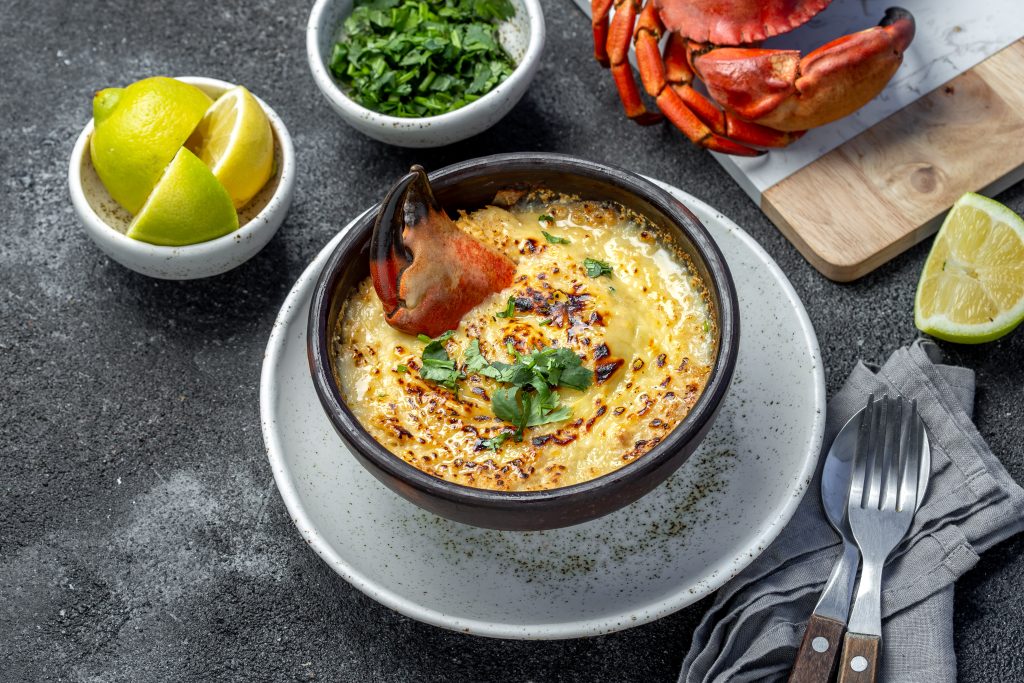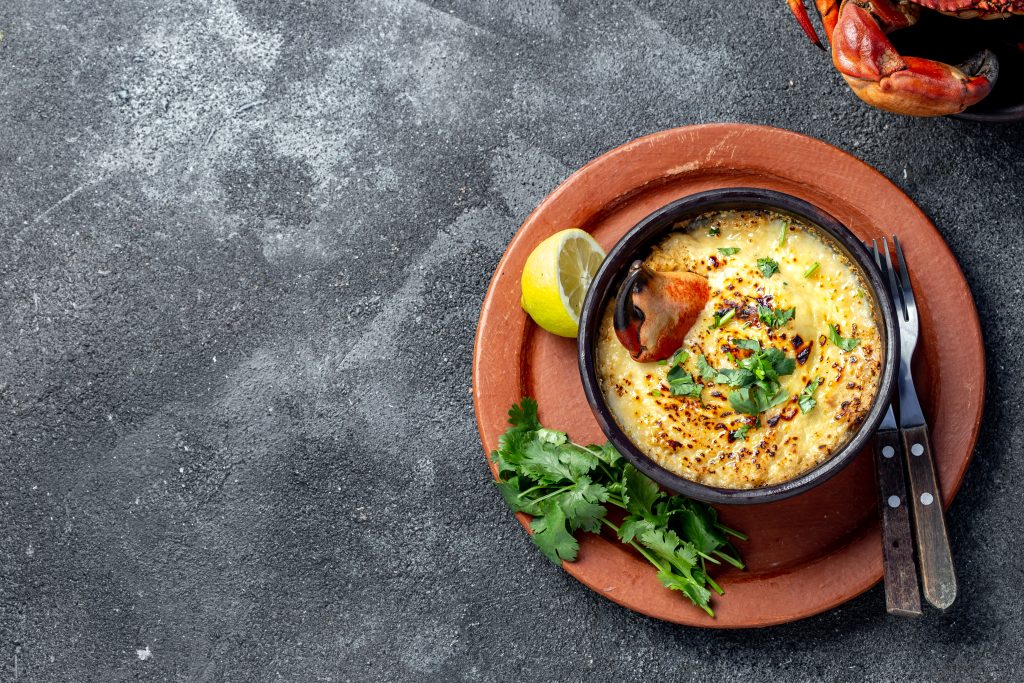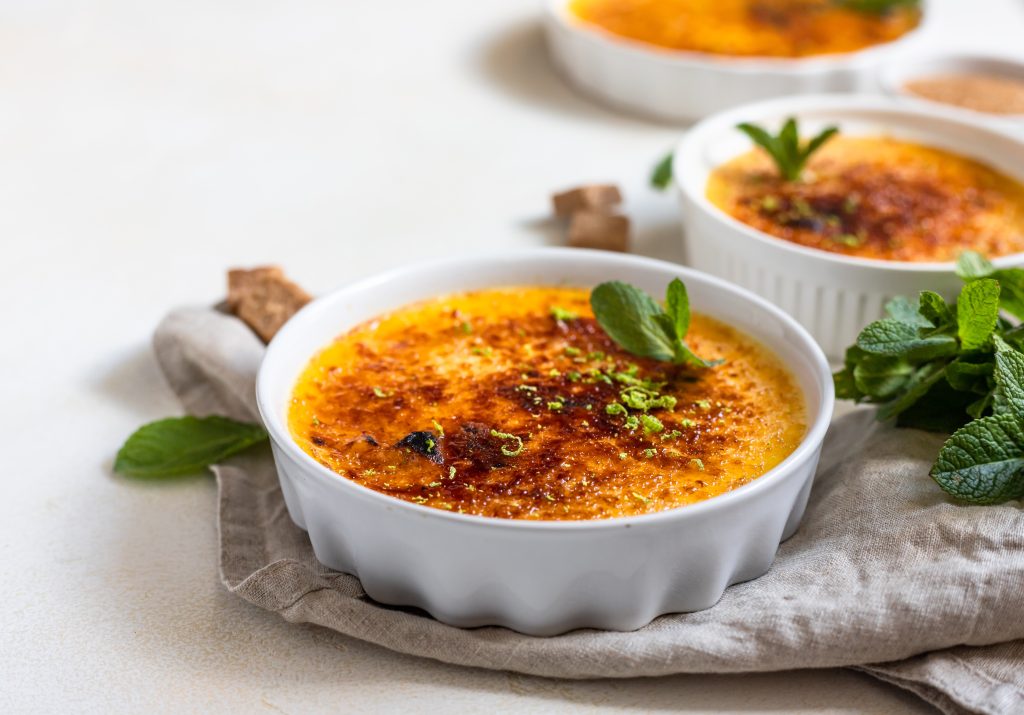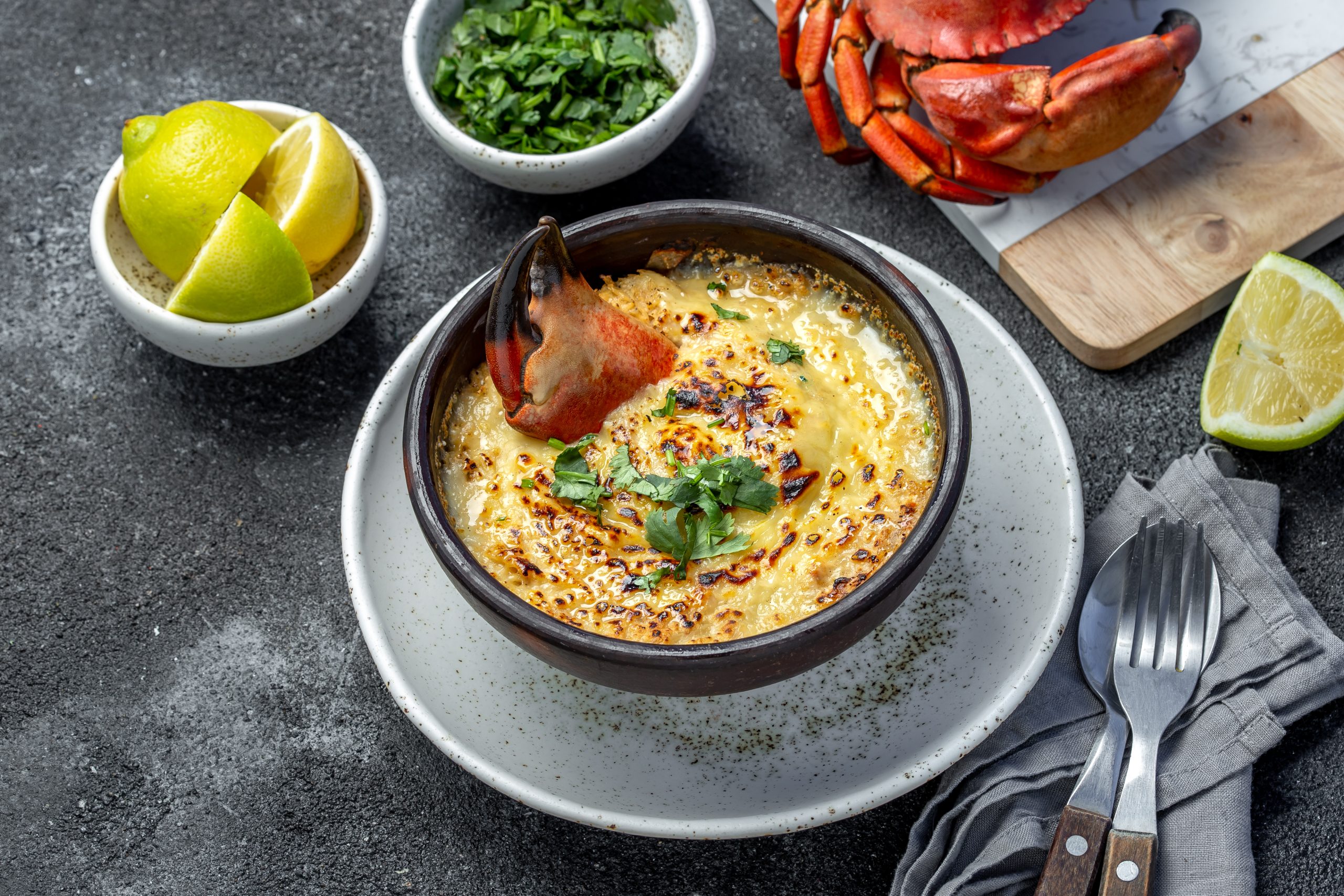
Crab Brulee is an exquisite dish that combines the richness of crème brûlée with the delicate flavors of fresh crab meat. This savory twist on a traditionally sweet dessert is perfect for those who love experimenting with gourmet seafood recipes. In this article, we will explore the origins of this dish, provide a detailed recipe, and offer tips for perfecting your own crab brulee at home.
Introduction to a Unique Seafood Dish
Crab Brulee Recipe is an innovative dish that offers a sophisticated blend of textures and flavors. The creaminess of the custard base, combined with the savory, tender crab meat, creates a dish that is both luxurious and comforting. This dish is an excellent choice for impressing guests at a dinner party or for indulging in a special meal at home.
For those looking to enhance their cooking skills further, exploring the ultimate guide to cooking and enjoying a Tomahawk steak can provide additional insights into creating impressive meals.
Origins of This Savory Twist
While crème brûlée has long been a favorite in French cuisine, the crab brulee Recipe variant has its roots in coastal regions where seafood is abundant. The idea of combining the rich, custardy texture of crème brûlée with the delicate flavor of crab meat likely originated as chefs sought new ways to showcase the versatility of seafood in their dishes. Today, crab brulee is a beloved dish among seafood enthusiasts and gourmet chefs alike.
To learn more about sustainable seafood choices, consider consulting the Monterey Bay Aquarium Seafood Watch, which provides valuable guidance on selecting the best and most eco-friendly seafood options.
Essential Ingredients for Crab Brulee
Creating the perfect crab brulee begins with selecting the right ingredients. Each component plays a crucial role in achieving the desired texture and flavor.
High-Quality Crab Meat
The star of this dish is, of course, the crab meat. Fresh, high-quality crab meat is essential for the best flavor. You can use fresh crab meat or opt for high-quality canned crab meat if fresh is not available. When purchasing fresh crab, ensure that it is sustainable and sourced responsibly. For more information on selecting sustainable seafood, visit the Monterey Bay Aquarium Seafood Watch.
Cream Types (Single vs. Heavy Cream)
The cream is another critical component of the crab brulee. Depending on your preference, you can use either single cream or heavy cream. Single cream will result in a lighter custard, while heavy cream will produce a richer, more indulgent texture.
Egg Yolks and Whole Eggs
Eggs are the foundation of the custard base. Most recipes call for a combination of egg yolks and whole eggs, which helps achieve the perfect balance between creaminess and stability. Typically, you will need about five large egg yolks and one whole egg.
Seasonings (Salt, Pepper, Garlic, Pickled Ginger)
The seasoning for crab brulee is relatively simple but highly effective. A pinch of salt, a dash of pepper, and a bit of minced garlic enhance the savory flavor of the dish. Some variations also include pickled ginger, which adds a subtle tangy note that pairs beautifully with the crab.
Optional Ingredients: Cheese, Liquor, Sugar
For those who want to add an extra layer of complexity to their crab brulee, consider incorporating ingredients such as grated cheese or a splash of liquor (e.g., sherry or brandy). A small amount of sugar can be added to the custard base to create a contrast between the savory custard and the caramelized sugar topping.
Choosing the Right Crab Meat
Selecting the right crab meat is crucial for the success of your crab brulee. Here’s what you need to know:
- Fresh vs. Canned Crab Meat: Fresh crab meat is always preferred for its superior flavor and texture. However, if fresh crab is not available, high-quality canned crab meat can be a suitable alternative. Look for brands that offer lump crab meat, which is known for its large, tender pieces.
- Sustainable Seafood Choices: When purchasing crab meat, opt for sustainably sourced options to support the health of our oceans. The Monterey Bay Aquarium Seafood Watch is an excellent resource for identifying sustainable seafood options.
Step-by-Step Guide to Preparing Crab Brulee
Now that you have your ingredients ready, it’s time to prepare your crab brulee. Follow these steps for a successful dish:
Preparing the Crab Meat
- Cleaning and Checking for Shell Fragments: Before incorporating the crab meat into your custard, carefully check for any shell fragments. Even small pieces can disrupt the smooth texture of the dish.
- Gently Breaking Up the Meat: If using lump crab meat, gently break it up into smaller pieces without shredding it too finely. This will help distribute the crab evenly throughout the custard.
Mixing the Base
- Combining Cream, Eggs, and Flavorings: In a large mixing bowl, whisk together the cream, egg yolks, whole egg, salt, pepper, garlic, and any other desired seasonings. Whisk until the mixture is smooth and well combined.
- Incorporating Crab Meat: Gently fold the crab meat into the custard base, taking care not to overmix. The goal is to evenly distribute the crab meat without compromising its texture.

Cooking Techniques for the Perfect Crab Brulee
Achieving the perfect crab brulee requires careful attention to cooking techniques.
Bain-Marie Method (Water Bath)
- Ensuring Even Cooking: The bain-marie method, also known as a water bath, is essential for cooking the custard evenly. Place the filled ramekins in a large baking dish, then add hot water until it reaches halfway up the sides of the ramekins. This method prevents the custard from overcooking and ensures a smooth, creamy texture.
For more on the bain-marie method and other gourmet cooking techniques, visit Serious Eats, a trusted source for culinary knowledge.
Temperature Control
- Ideal Baking Temperature: Preheat your oven to 325°F (163°C). Bake the crab brulee until the custard is set but still slightly jiggly in the center, about 30-40 minutes. Overbaking can result in a grainy texture, so keep a close eye on the custards.
Achieving the Perfect Caramelized Crust
- Using a Kitchen Torch vs. Broiler: The iconic caramelized sugar crust of a crab brulee can be achieved using a kitchen torch or a broiler. Sprinkle a thin layer of sugar over each custard, then use a torch to caramelize it evenly. If you don’t have a torch, place the custards under a preheated broiler until the sugar melts and forms a crispy crust.
Common Mistakes to Avoid When Making Crab Brulee
Even with the best intentions, there are a few common mistakes that can impact the outcome of your crab brulee. Here’s how to avoid them:
- Overcooking or Undercooking: As mentioned earlier, overcooking can lead to a grainy texture, while undercooking can leave the custard too runny. Use the bain-marie method and monitor the custards closely during baking.
- Improper Seasoning: Underseasoning can result in a bland dish, while overseasoning can overpower the delicate flavor of the crab. Start with small amounts of salt and pepper, then adjust to taste.
- Texture Issues: Achieving the right custard consistency is crucial. If the mixture is too runny before baking, it may indicate that the egg-to-cream ratio is off. On the other hand, if the mixture is too thick, the custard may turn out overly dense.
Creative Variations of Crab Brulee
Once you’ve mastered the basic crab brulee recipe, consider experimenting with these creative variations:
- Spicy Crab Brulee: Add a pinch of cayenne pepper or a dash of hot sauce to the custard base for a subtle kick.
- Cheese-Enhanced Crab Brulee: Incorporate a small amount of grated cheese, such as Parmesan or Gruyère, into the custard for an extra layer of richness.
- Herb-Infused Crab Brulee: Mix in finely chopped fresh herbs like dill, chives, or tarragon for a burst of flavor.
For more culinary inspiration, you might enjoy experimenting with other unique recipes, such as these delicious and healthy cottage cheese recipes, which offer a delightful balance of taste and nutrition.

Serving Suggestions and Pairings
Presentation is key when serving crab brulee Recipe. Here are some tips to ensure your dish looks as good as it tastes:
- Presentation Tips: Serve the crab brulee recipe in individual ramekins for an elegant touch. Garnish each ramekin with a sprig of fresh herbs or a thin slice of lemon for a pop of color.
- **Best Serving Temperatures**: *Crab brulee* can be served warm or at room temperature. If serving at room temperature, allow the custards to cool slightly after caramelizing the sugar crust.
- Garnishing Ideas: Consider garnishing the dish with a light drizzle of high-quality olive oil or a sprinkle of sea salt to enhance the flavors.
Pairing Crab Brulee recipe with Sides and Drinks
To complete your crab brulee experience, consider pairing it with complementary sides and drinks.
Wine Pairings
- Suggested White Wines: A crisp, dry white wine such as Sauvignon Blanc or Chardonnay pairs beautifully with crab brulee. The acidity of the wine helps cut through the richness of the dish.
For expert advice on wine pairings, visit Wine Folly, a go-to resource for wine enthusiasts.
Accompanying Dishes
- Light Salads and Crusty Bread: Serve crab brulee alongside a simple green salad dressed with a light vinaigrette. A slice of crusty bread is also a great addition, providing a satisfying contrast to the creamy custard.
FAQs About Crab Brulee recipe
Here are the answers to your questions:
Do you have to use ramekins for crème brûlée?
While ramekins are traditional for making crème brûlée due to their size and shape, which help ensure even cooking and a perfect caramelized top, they aren’t strictly necessary. You can use other small, oven-safe dishes like shallow ceramic bowls or even small glass jars. The key is to ensure the dish is shallow enough to allow for the right custard-to-caramelized-sugar ratio.
Can you use store-bought custard for crème brûlée?
Yes, you can use store-bought custard as a shortcut for making crème brûlée. However, the flavor and texture might not be as rich and creamy as homemade custard. If you decide to use store-bought custard, be sure to heat it gently and add a bit of extra cream or egg yolk to enrich it before baking and caramelizing the top.
How to caramelize brulee?
To caramelize the sugar topping on a crème brûlée, sprinkle an even layer of granulated sugar over the chilled custard. Use a kitchen torch to gently heat the sugar until it melts and turns a deep amber color, forming a crispy, caramelized crust. If you don’t have a torch, you can place the custards under a preheated broiler, watching carefully to prevent burning.
Is crème brûlée served hot or cold?
Crème brûlée is traditionally served chilled, with a contrasting warm, freshly caramelized sugar crust. The cold custard and warm topping create a delightful contrast in both temperature and texture, making it a unique and enjoyable dessert experience.
To help you master the art of making crab brulee Here are the answers to your questions:
Do you have to use ramekins for crème brûlée?
While ramekins are traditional for making crème brûlée due to their size and shape, which help ensure even cooking and a perfect caramelized top, they aren’t strictly necessary. You can use other small, oven-safe dishes like shallow ceramic bowls or even small glass jars. The key is to ensure the dish is shallow enough to allow for the right custard-to-caramelized-sugar ratio.
Can you use store-bought custard for crème brûlée?
Yes, you can use store-bought custard as a shortcut for making crème brûlée. However, the flavor and texture might not be as rich and creamy as homemade custard. If you decide to use store-bought custard, be sure to heat it gently and add a bit of extra cream or egg yolk to enrich it before baking and caramelizing the top.
How to caramelize brulee?
To caramelize the sugar topping on a crème brûlée, sprinkle an even layer of granulated sugar over the chilled custard. Use a kitchen torch to gently heat the sugar until it melts and turns a deep amber color, forming a crispy, caramelized crust. If you don’t have a torch, you can place the custards under a preheated broiler, watching carefully to prevent burning.
Is crème brûlée served hot or cold?
Crème brûlée is traditionally served chilled, with a contrasting warm, freshly caramelized sugar crust. The cold custard and warm topping create a delightful contrast in both temperature and texture, making it a unique and enjoyable dessert experience., here are answers to some frequently asked questions:
What kind of crab is best for crab brulee?
Fresh, lump crab meat is ideal for crab brulee due to its sweet flavor and tender texture. Dungeness and blue crabs are excellent choices.
Do you have to use ramekins for crème brûlée?
While ramekins are traditional for making crème brûlée due to their size and shape, which help ensure even cooking and a perfect caramelized top, they aren’t strictly necessary. You can use other small, oven-safe dishes like shallow ceramic bowls or even small glass jars. The key is to ensure the dish is shallow enough to allow for the right custard-to-caramelized-sugar ratio.
Can you use store-bought custard for crème brûlée?
Yes, you can use store-bought custard as a shortcut for making crème brûlée. However, the flavor and texture might not be as rich and creamy as homemade custard. If you decide to use store-bought custard, be sure to heat it gently and add a bit of extra cream or egg yolk to enrich it before baking and caramelizing the top.
How to caramelize brulee?
To caramelize the sugar topping on a crème brûlée, sprinkle an even layer of granulated sugar over the chilled custard. Use a kitchen torch to gently heat the sugar until it melts and turns a deep amber color, forming a crispy, caramelized crust. If you don’t have a torch, you can place the custards under a preheated broiler, watching carefully to prevent burning.
Is crème brûlée served hot or cold?
Crème brûlée is traditionally served chilled, with a contrasting warm, freshly caramelized sugar crust. The cold custard and warm topping create a delightful contrast in both temperature and texture, making it a unique and enjoyable dessert experience.
Can I use frozen crab meat?
Yes, frozen crab meat can be used, but ensure it is fully thawed and excess moisture is removed before using it in the recipe.
How do I store leftover crab brulee?
Leftover crab brulee should be covered and refrigerated. It can be stored in the fridge for up to 2 days.
What’s the best way to reheat crab brulee?
To reheat, place the crab brulee in a preheated oven at 300°F (150°C) for about 10 minutes, or until warmed through. Avoid reheating in the microwave, as it can ruin the texture.
Can crab brulee be made ahead of time?
Yes, you can prepare the custard and refrigerate it for up to 24 hours before baking. Caramelize the sugar topping just before serving to ensure it remains crispy.
Conclusion
Crab Brulee is a sophisticated dish that combines the best of both worlds: the creamy texture of custard and the delicate, savory flavor of crab meat. By following this detailed guide, you can create a stunning crab brulee that will impress even the most discerning palates. Remember to select high-quality, sustainable ingredients, pay attention to cooking techniques, and don’t be afraid to experiment with variations. Whether served as an appetizer or a main course, crab brulee is sure to become a favorite in your culinary repertoire.
For more culinary inspiration and gourmet cooking techniques, be sure to check out Serious Eats and Wine Folly. Additionally, explore other delightful recipes like this guide to making cottage cheese bread, which is perfect for a cozy, homemade treat.

